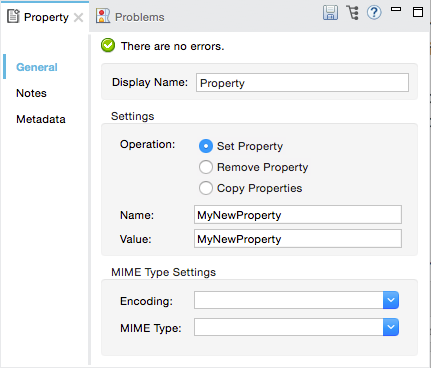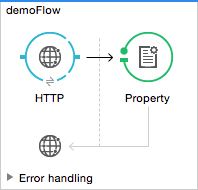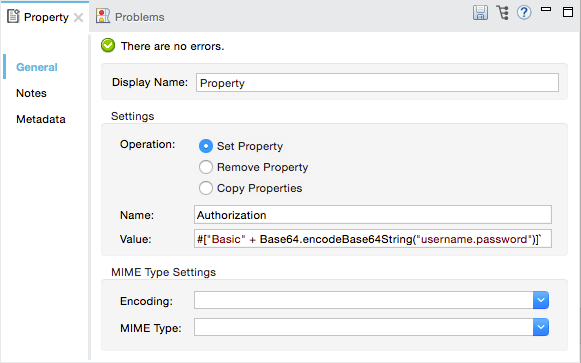<choice doc:name="Choice">
<when expression="#[message.outboundProperties['timeStamp']]">
<logger level="INFO" doc:name="Logger"/>
</when>
<otherwise>
...
</otherwise>
</choice>xmlProperty Transformer Reference
Use a property transformer to set, remove, or copy properties on the outbound scope of a message. This transformer transforms only outbound properties. Note that you cannot manipulate inbound scope properties, as those are automatically generated by the message source. To learn more about message scopes, refer to Mule Concepts.
The property transformer differs from the variable transformer and the session variable transformer. Refer to the table below for a comparison of these three transformers.
| Property Transformer | Variable Transformer | Session Variable Transformer | |
|---|---|---|---|
Use |
Use to set, remove, or copy properties on the outbound scope of a message. |
Use to set or remove a variable on the message, tied to the current flow. |
Use to set or remove a variable that is tied to the current message for its entire lifecycle, across multiple flows, applications, and even servers. |
Persistence |
Once a message hits an outbound-connector, all properties in the outbound scope are sent with the message, in the form of transport-specific metadata (HTTP headers for an HTTP outbound-connector, for example). |
Variables set with a variable transformer persist only for the current flow and cannot cross the transport barrier. |
Session variables set with a session variable transformer persist for the entire message lifecycle, regardless of transport barriers. |
To access the property that you have set on a message earlier in a flow, or in a different flow in the application, use a MEL expression. For example, if you want to route messages according to the timeStamp property you added to the header earlier in processing, you can use an expression in a choice router to access the outboundProperties property and route accordingly. Refer to the example below, where the expression #[message.outboundProperties=timeStamp] accesses the timeStamp property and evaluates to the value of the property.
Configuration
Studio Visual Editor

| Field | Value | Description |
|---|---|---|
Display Name |
Property |
Customize to display a unique name for the transformer in your application. XML: |
Operation |
Set Property |
Select to set a new property on the outbound scope of your message (as shown in example above). XML: |
Remove Property |
Select to delete an existing property from your message to remove it from the outbound scope. XML: |
|
Copy Properties |
Select to copy an existing property from the inbound scope onto the outbound scope of your message. XML: `<copy-properties> ` |
|
Name |
String or Mule Expression |
Specify the name of the property that you are creating, or identify the name of the property that you are copying or removing. If you are copying or removing properties, this field accepts a wildcard "*" character. XML: |
Value |
String or Mule Expression |
This field displays only if you are setting a new property. Specify the value using either a string or a Mule expression, as shown in the example screenshot above. XML: |
MIME Encoding |
Set from drop-down |
Specify an optional language for encoding content. This field only displays when you set a property. XML: |
MIME Type |
Set from drop-down |
Specify an optional MIME type for encoding content. This field only displays when you set a property. XML: |
XML Editor or Standalone
#Set property <set-property propertyName="Authorization" doc:name="Set Authentication Header" value="#['Basic ' + org.apache.commons.codec.binary.Base64.encodeBase64String('${user}:${password}'.getBytes())]"/> # Remove property <remove-property propertyName="PropertyForRemoval" doc:name="Delete Property"/> # Copy property <copy-properties propertyName="http.*" doc:name="Copy All HTTP Headers"/>text
| Element | Description |
|---|---|
set-property |
Set a new property on the outbound scope of your message (as shown in example below). |
remove-property |
Delete an existing property from your message to remove it from the outbound scope. |
copy-properties |
Copy an existing property from the inbound scope onto the outbound scope of your message |
| Element Attribute | Description |
|---|---|
doc:name |
Customize to display a unique name for the transformer in your application, as shown in the example below. Note: Attribute not required in Mule Standalone configuration. |
propertyName |
The name of the property that you are setting, copying, or removing. Can be a string or a Mule expression. Note: If you are using the remove-property or copy-properties element, you may use a wildcard "" character. For example, a copy-properties transformer with a property name "http." copies all properties whose names begin with "http." from the inbound scope to the outbound scope. |
value |
The value of the property that you are setting. This attribute is only relevant for the set-property element. Can be a string or a Mule expression. |
Example
In the example below, we want to connect to a web service protected by an HTTP basic authentication mechanism. In order to do that, our HTTP request needs to include a header, Authorization, which contains the username and password that allows the request go through. The properties transformer shown below sets an outbound property named Authorization and applies the value that is required to authenticate the message.
Studio Visual Editor

The following sets a property with:
-
Name:
Authorization -
Value:
#["Basic" + Base64.encodeBase64String("username.password")]

XML Editor or Standalone
<http:listener-config name="listener-config" host="localhost" port="8081"/>
<http:request-config name="request-config" host="localhost"
port="8081"/>
<flow name="PropertyTransformingFlow" doc:name="PropertyTransformingFlow">
<http:listener config-ref="listener-config" path="/" doc:name="HTTP Connector"/>
<set-property propertyName="Authorization" doc:name="Set Authentication Header" value="#['Basic ' + org.apache.commons.codec.binary.Base64.encodeBase64String('${user}:${password}'.getBytes())]"/> <http:request config-ref="request-config" path="/" method="POST" doc:name="HTTP Connector"/>
</flow>xmlComplete Code Example
<mule xmlns:http="http://www.mulesoft.org/schema/mule/http"
xmlns="http://www.mulesoft.org/schema/mule/core" xmlns:doc="http://www.mulesoft.org/schema/mule/documentation" xmlns:spring="http://www.springframework.org/schema/beans" xmlns:xsi="http://www.w3.org/2001/XMLSchema-instance" xsi:schemaLocation="
http://www.mulesoft.org/schema/mule/http http://www.mulesoft.org/schema/mule/http/current/mule-http.xsd http://www.springframework.org/schema/beans http://www.springframework.org/schema/beans/spring-beans-current.xsd
http://www.mulesoft.org/schema/mule/core http://www.mulesoft.org/schema/mule/core/current/mule.xsd">
<http:listener-config name="listener-config" host="localhost" port="8081"/>
<http:request-config name="request-config" host="localhost"
port="8081"/>
<flow name="PropertyTransformingFlow" doc:name="PropertyTransformingFlow">
<http:listener config-ref="listener-config" path="/" doc:name="HTTP Connector"/>
<set-property propertyName="Authorization" doc:name="Set Authentication Header" value="#['Basic ' + org.apache.commons.codec.binary.Base64.encodeBase64String('${user}:${password}'.getBytes())]"/>
<remove-property propertyName="PropertyForRemoval" doc:name="Delete Property"/>
<copy-properties propertyName="http.*" doc:name="Copy All HTTP Headers"/>
<http:request config-ref="request-config" path="/" method="POST" doc:name="HTTP Connector"/>
</flow>xmlReferencing Properties Elsewhere
After you set a new property, how do you call it and use it elsewhere in your flow?
-
If you select any component in your flow that precedes the creation of the property, you can see the component in the Metadata Explorer, under the Outbound Properties section.

-
You can reference the component in any field in any component that accepts Mule Expression Language (MEL), calling it through the following expression:
#[message.outboundProperties.propertyName]
| In Studio, the autocomplete feature can help you out by displaying a list of available properties at that particular part of the flow. Position your cursor in a field and press CTRL + Space to see field options. For more information, see Anypoint Studio Essentials > Show Attribute Options. |
-
You can reference a component inside any custom Java Class, calling it through the following:
message.getOutboundProperty("propertyName");
See a basic Java Class that implements this
package org.mule.transformers;
import org.mule.api.MuleMessage;
import org.mule.api.transformer.TransformerException;
import org.mule.transformer.AbstractMessageTransformer;
public class setPropertyAsPayload extends AbstractMessageTransformer{
/**
* @param args
*/
public Object transformMessage(MuleMessage message, String outputEncoding) throws TransformerException {
String newPayload = message.getOutboundProperty("myProperty");
return newPayload;
}
}java
This Java Class takes an existing property named myProperty and makes it into the message payload.
|
See Also
-
Refer to Mule Concepts to learn more about message scopes.
-
Read about related transformers, the variable transformer and the session variable transformer, which you can use to set variables for different scopes.
-
Learn how to use Mule Expression Language (MEL) to read and, when allowed, manipulate properties using the
inboundPropertiesandoutboundPropertiesmaps.



